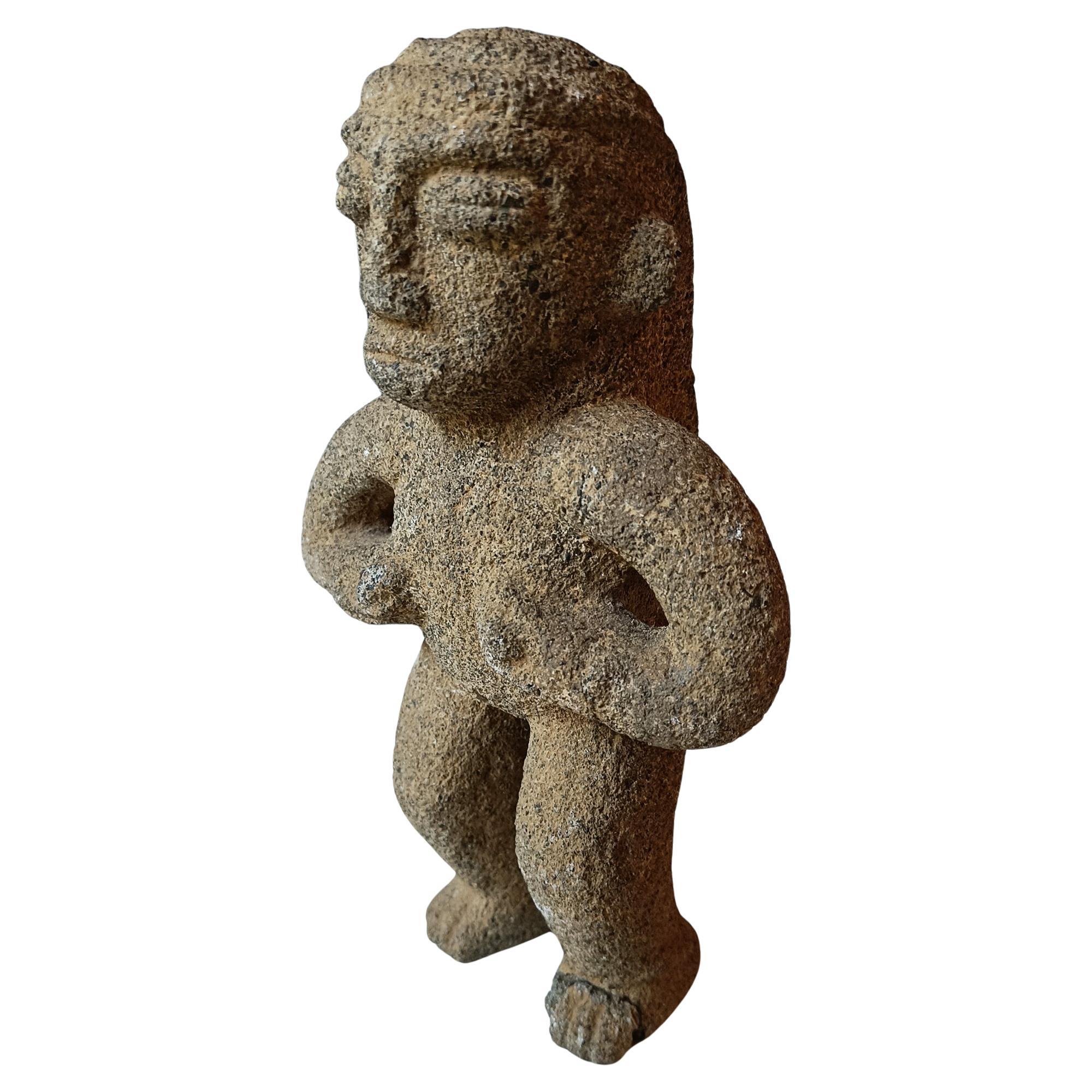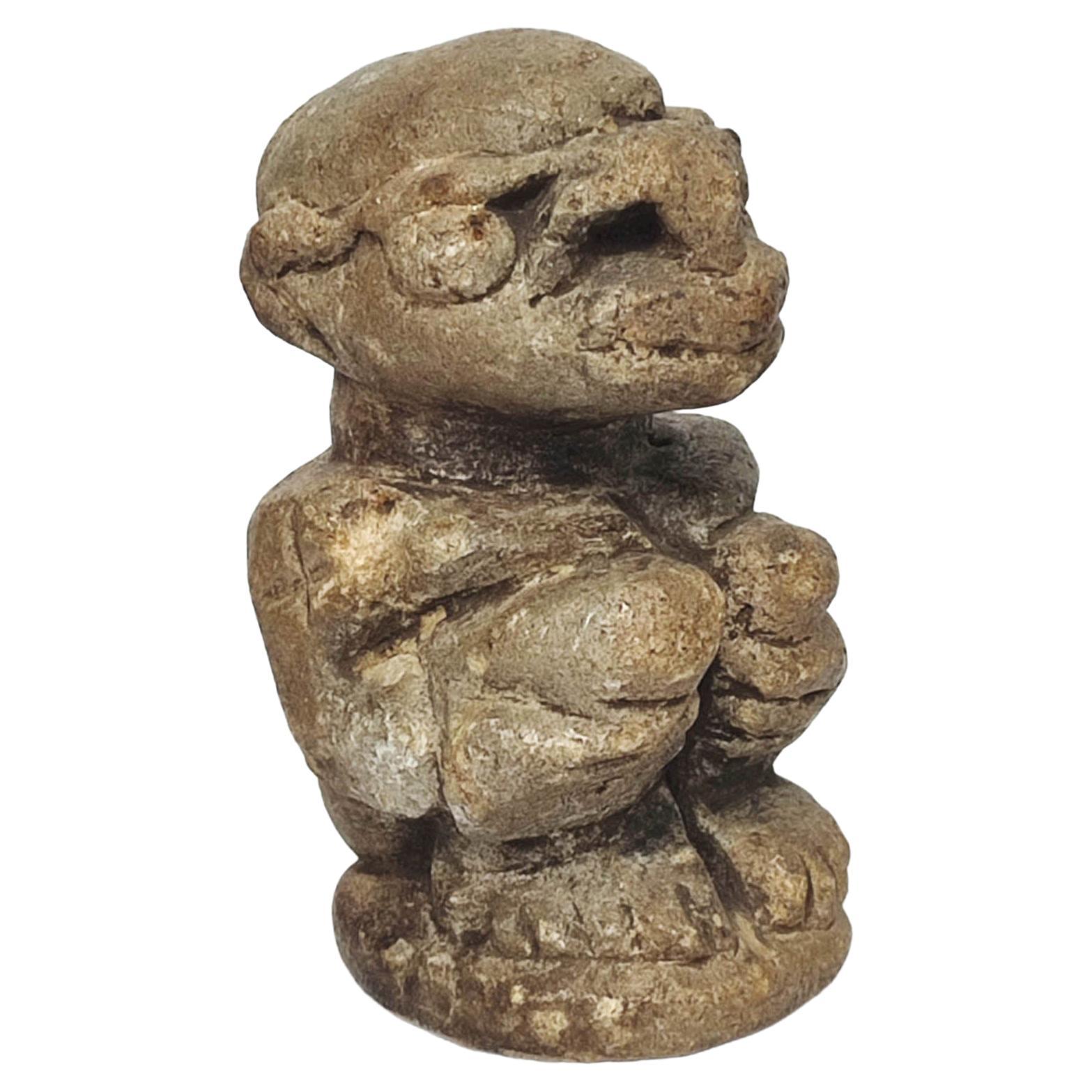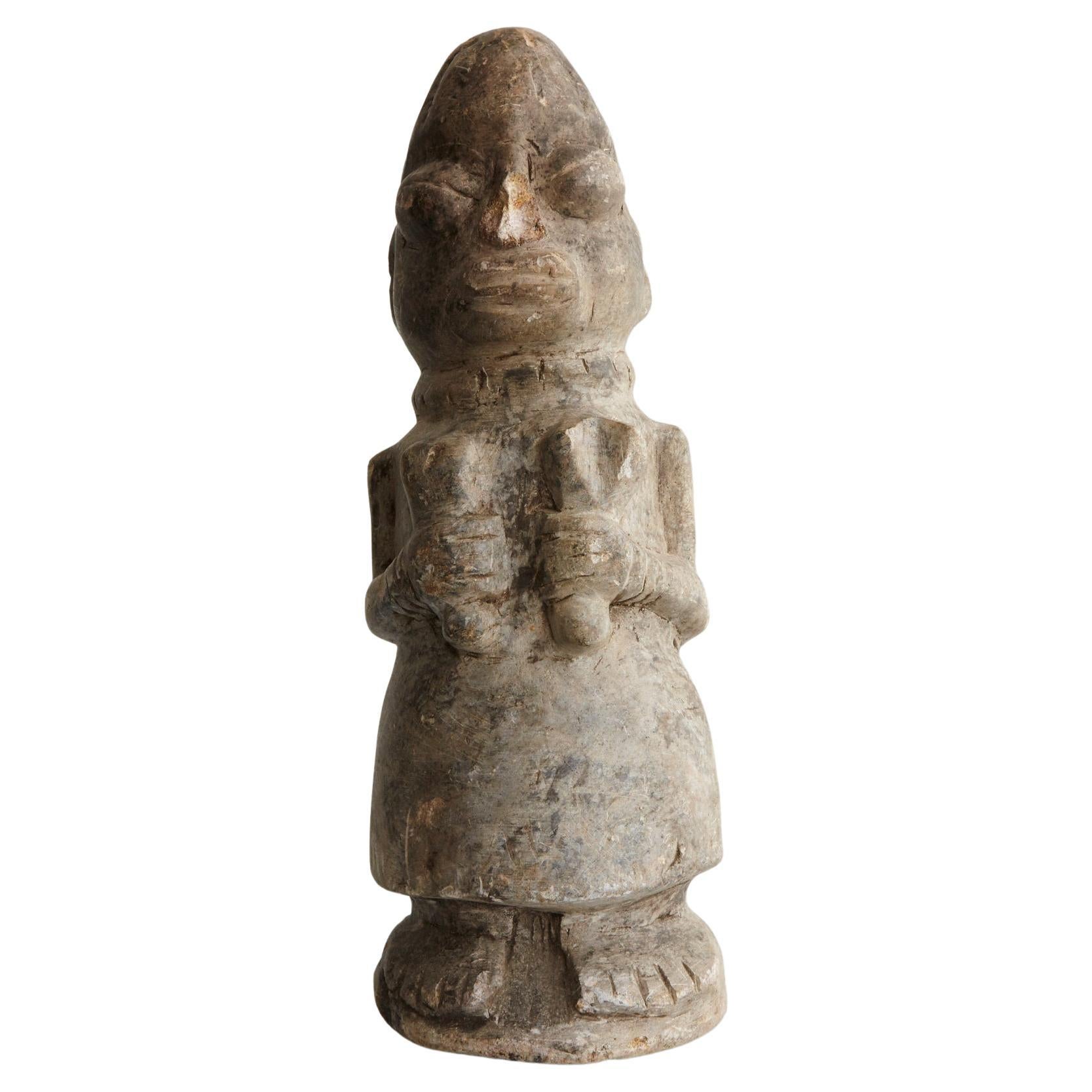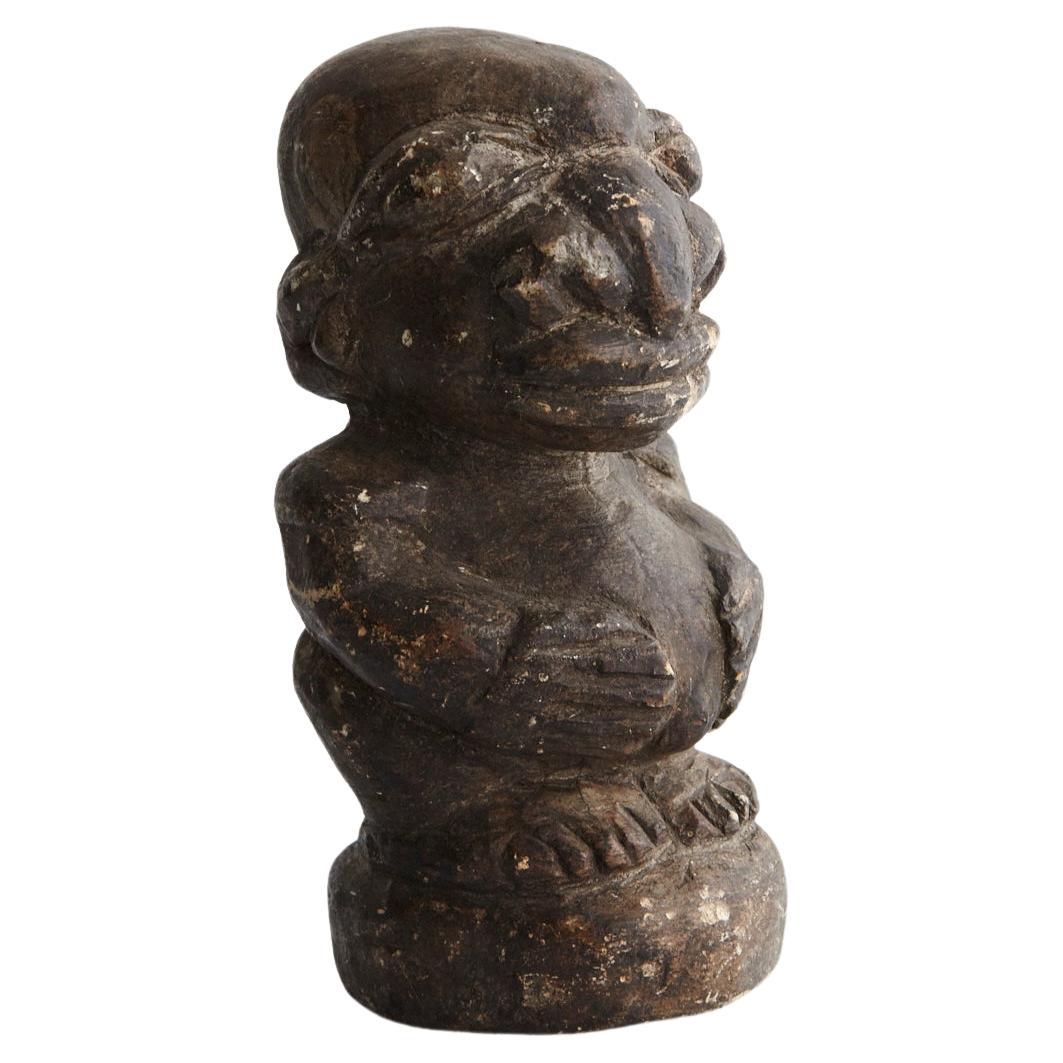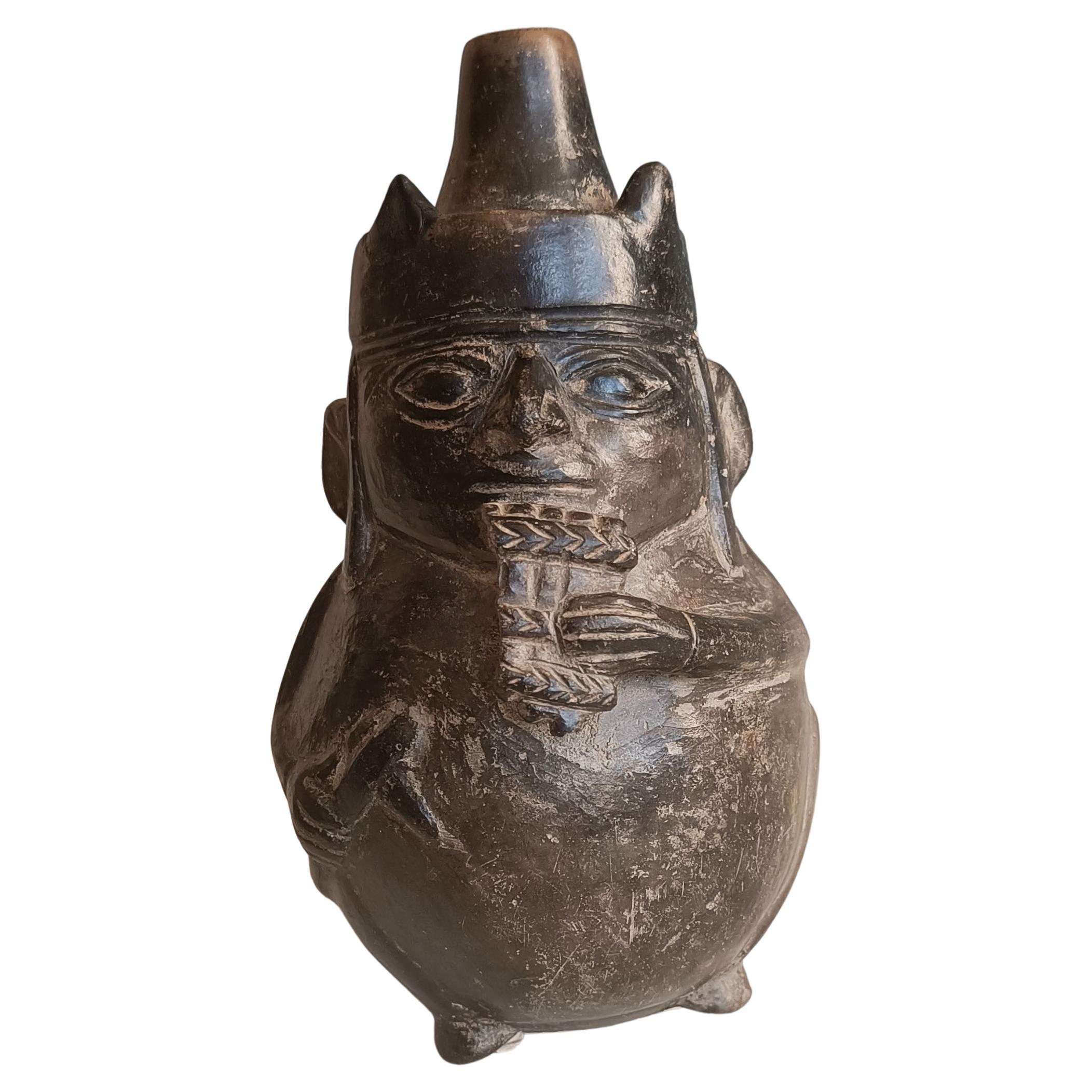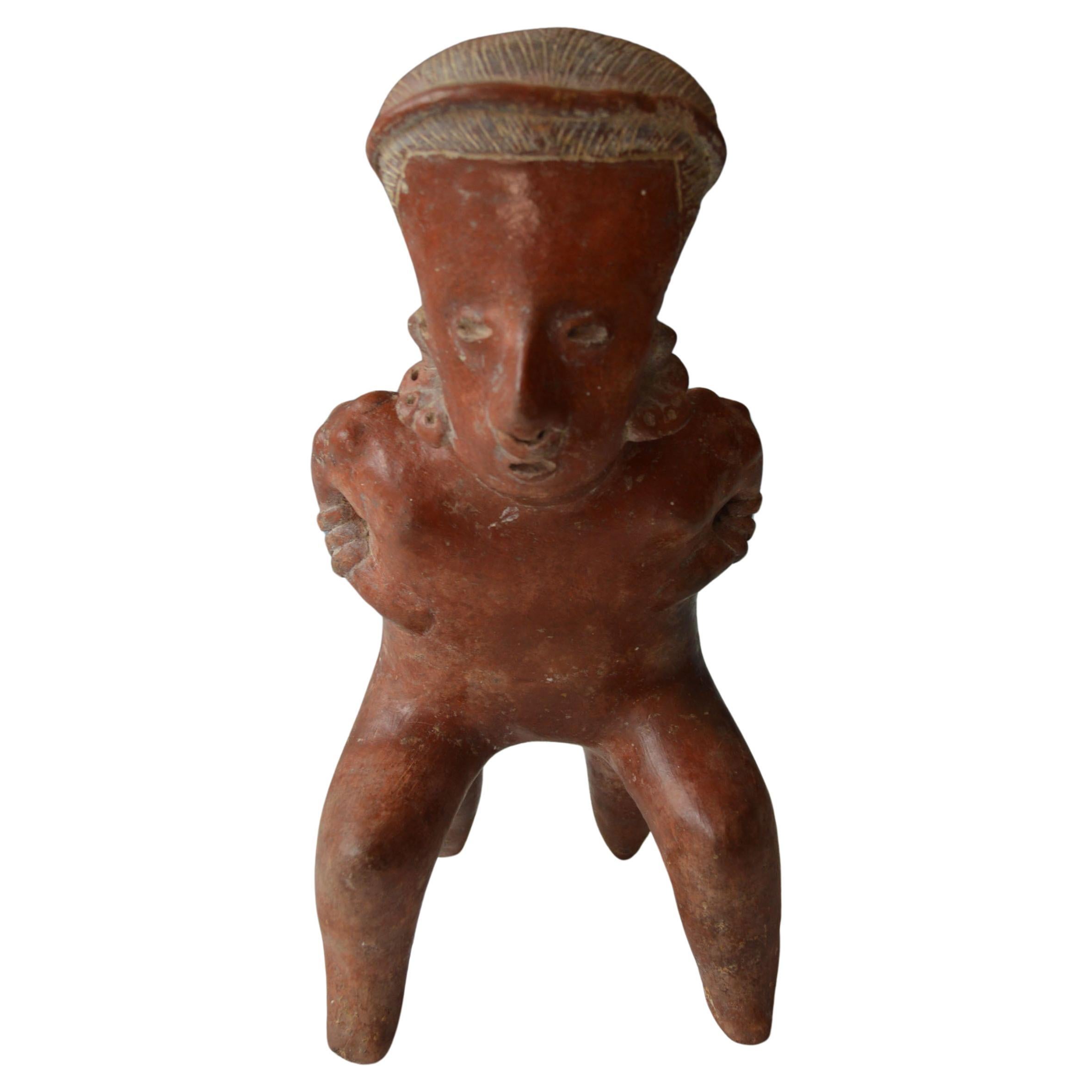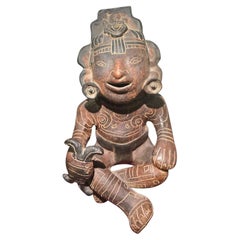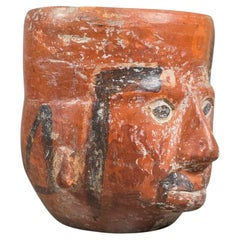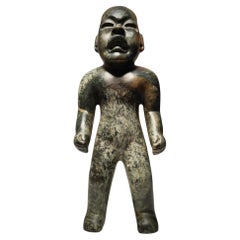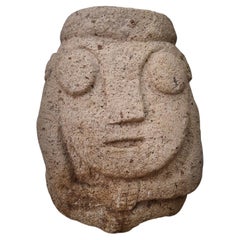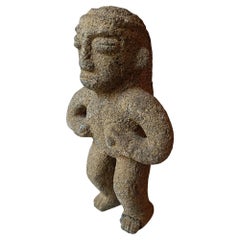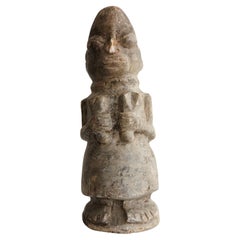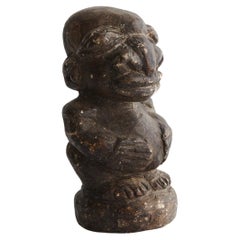Items Similar to Small Pre-Columbian Figurine – Ritual Stone Amulet
Want more images or videos?
Request additional images or videos from the seller
1 of 10
Small Pre-Columbian Figurine – Ritual Stone Amulet
$500.82per set
£379.38per set
€430per set
CA$693.82per set
A$778.16per set
CHF 407.51per set
MX$9,455.40per set
NOK 5,174.70per set
SEK 4,905.98per set
DKK 3,273.92per set
About the Item
An expressive and finely carved miniature Pre-Columbian figurine, measuring just 4 cm in height, yet rich in symbolic character and presence. Crafted from stone, the figure depicts a stylized human form seated or standing with hands cradling the torso—possibly signifying fertility, protection, or ritualistic significance.
The figure’s facial features are bold and abstract, with prominent blackened incisions accentuating the eyes, mouth, and other details, likely applied with mineral pigments. The back and sides are smoothly worked, and the surface exhibits a warm patina, evidence of centuries of age and handling.
Miniature sculptures such as this are often associated with personal devotion, funerary rites, or shamanic practices in ancient Pre-Columbian cultures. This example, with its compact size and strong sculptural presence, is a striking representation of early ritual art from the Americas.
Details:
Culture: Pre-Columbian
Date: Circa 1000–1400 CE (estimated)
Material: Carved stone with mineral pigment traces
Dimensions: 4 x 2 x 2 cm (1.6 x 0.8 x 0.8 in)
Condition: Excellent condition considering age; light surface wear and natural mineral deposits consistent with archaeological origin.
A rare collector’s piece ideal for those drawn to ancient symbolism, early American artistry, and compact objects with profound cultural resonance.
- Dimensions:Height: 1.58 in (4 cm)Width: 0.79 in (2 cm)Depth: 0.79 in (2 cm)
- Sold As:Set of 2
- Style:Tribal (Of the Period)
- Materials and Techniques:
- Place of Origin:
- Period:
- Date of Manufacture:1400
- Condition:Wear consistent with age and use.
- Seller Location:Madrid, ES
- Reference Number:1stDibs: LU5779245038442
About the Seller
4.8
Platinum Seller
Premium sellers with a 4.7+ rating and 24-hour response times
Established in 2005
1stDibs seller since 2021
364 sales on 1stDibs
Typical response time: 1 hour
- ShippingRetrieving quote...Shipping from: Madrid, Spain
- Return Policy
Authenticity Guarantee
In the unlikely event there’s an issue with an item’s authenticity, contact us within 1 year for a full refund. DetailsMoney-Back Guarantee
If your item is not as described, is damaged in transit, or does not arrive, contact us within 7 days for a full refund. Details24-Hour Cancellation
You have a 24-hour grace period in which to reconsider your purchase, with no questions asked.Vetted Professional Sellers
Our world-class sellers must adhere to strict standards for service and quality, maintaining the integrity of our listings.Price-Match Guarantee
If you find that a seller listed the same item for a lower price elsewhere, we’ll match it.Trusted Global Delivery
Our best-in-class carrier network provides specialized shipping options worldwide, including custom delivery.More From This Seller
View AllLarge Decorative Pre-Columbian Style Figure – 20th Century
Located in Madrid, ES
Impressive Pre-Columbian style figure from the 20th century, crafted in homage to ancient Mesoamerican art. The piece showcases stylized facial features and traditional ornamentation...
Category
Vintage 1950s Figurative Sculptures
Materials
Terracotta
Pre-Columbian ceramics can– Tiahuanaco Culture
Located in Madrid, ES
"Pre-Columbian Ceramics – Tiahuanaco Culture"
Material: ceramics
Origin: Southern Sierra of Peru, Lake Titicaca Plateau
Period: Boom Age (1 AD – 800 AD)
Dimensions: 11 x 10 cm diamet...
Category
Antique 15th Century and Earlier South American Tribal Ceramics
Materials
Ceramic
Important Olmec figure of Olmec ethnic dignitary from the preclassic period
Located in Madrid, ES
Important Olmec figure of Olmec ethnic dignitary from the preclassic period (2500-200 BC)
Important Olmec figure of dignitary of the Olmec ethnic group of...
Category
Antique 15th Century and Earlier Figurative Sculptures
Materials
Precious Stone
$14,395 Sale Price
20% Off
Stone Carved Anthropomorphic Sculpture From The Recuay Culture Peru 400bc-400ac
Located in Madrid, ES
ANTHROPOMORPHIC SCULPTURE CARVED IN STONE OF THE RECUAY CULTURE PERU 400BC-400AC
Recuay is an archaeological culture of Ancient Peru that developed in the Sierra of the current Peruvian department of Áncash between 200 AD. C. until 600 d. C. It corresponds to the stage called Regional Developments, it has also been called the Huaylas or Santa culture.
Like the other Early Intermediate cultures, little is known about this culture. The most accepted position is that it was an extension of the Chavin culture, after the influence of the "White on Red" style in the region. Regarding the political aspect of the recuay, there is a hypothesis that questions their autonomy and maintains that Recuay would be part of one of the many political units that made up the Moche state.
The recuay style, characterized by its ceramics and stone sculpture, was initially described by Eduard Seler in 1893, based on ceramic specimens brought to the Ethnographic Museum in Berlin by Mariano M. Macedo. Seler named this style of pottery Recuay, based on the report that these pieces had been found in the town of Recuay. Later studies showed that this characteristic pottery was not originally from Recuay but from Copa, near Carhuaz, for which reason the name change to that of this town was proposed. Eventually the name of Huaylas was used for this culture. In 1919 Julio C. Tello explored the area and recovered lithic sculptures and Recuay-type ceramics. In the 1960s Rafael Larco Hoyle proposed changing the names of Recuay and Copa to Santa, arguing that the Recuay style had originated in the coastal regions of the Santa Valley. However, the name Recuay has persisted.
Its chronology is also highly debatable. The time of its origin between 0 and 200 AD is discussed. C. and its end or collapse is commonly set to 600 d. C. probably caused by the invasion of the Huari conquerors.
It encompassed almost the entire Callejón de Huaylas, a narrow valley fed by the Santa River and enclosed between two mountain ranges, the Cordillera Blanca to the west and the Cordillera Negra to the east. Its influence extended to the east to the Marañón river basin and to the west to the upper parts of the Santa, Casma and Huarmey valleys. To the north it reached the town of Pashash, in the province of Pallasca.
The Copa area, Marca district, Recuay province, Ancash department seems to have been the center or main nucleus of cohesion of this culture. The name of the culture would then be justified, derived from the province of the same name. Other important settlements were those of Huilcahuaín (near the current city of Ancash), Cátac, Araucay, Tambo, Jancu, Upayacu and Pashash (near the current city of Cabana).
Its main form of expression of art was through stone work (carving and masonry), inherited from its predecessor, the Chavín culture. In addition, they made sculptures in lumps that represent warriors with shields or trophy heads, with which they decorated their complex architectural constructions. They also made white clay pottery...
Category
Antique 15th Century and Earlier Figurative Sculptures
Materials
Stone
$40,997 Sale Price
20% Off
Pre-Columbian Chavín vessel, 900 BC – 300 BC.
Located in Madrid, ES
Pre-Columbian vessel from the Chavín culture in the form of a seated man, probably a hunter, with an animal on his back.
Chavín art is known for its complex iconography and mythical ...
Category
Antique 15th Century and Earlier South American Tribal Ceramics
Materials
Earthenware
Pre-Columbian Zoomorphic Ceramic Vessel
Located in Madrid, ES
A striking Pre-Columbian ceramic vessel shaped in a zoomorphic form, likely representing a dog or similar sacred animal figure, characterized by its expressive, upward-facing open mo...
Category
Antique 15th Century and Earlier South American Tribal Ceramics
Materials
Ceramic
You May Also Like
Pre Columbian Female Stone Fertility figure Costa Rica
Located in London, GB
Pre Columbian Female Stone Fertility figure Costa Rica
Pre-Columbian, Central America, Costa Rica, Central Highlands, Atlantic Watershed, C. 1000 to 1400 CE.
A carved volcanic stone ...
Category
Antique 15th Century and Earlier Costa Rican Antiquities
Materials
Stone
Nomoli Stone Figure, Sierra Leone, Kissi, Tribal Art
Located in Bochum, NRW
A Kissi Nomoli carved stone figure, a male with his hands wrapped around his knees, on a base; from the Kissi people of Sierra Leone.
Greyish brown patina, snout-like mouth, large no...
Category
Antique Late 19th Century Sierra Leonean Tribal Figurative Sculptures
Materials
Soapstone
Nomoli - Carved Stone Figurine, Kissi People, Sierra Leone, 19th Century
Located in Aramits, Nouvelle-Aquitaine
A Nomoli is a carved stone figurine native to Sierra Leone and Liberia. They are usually made of soapstone, limestone, or granite.
The carving depicts a woman in a dress and choker,...
Category
Antique 19th Century Sierra Leonean Tribal Tribal Art
Materials
Stone, Soapstone
Nomoli - Carved Stone Figurine, Kissi People, Sierra Leone, 19th Century
Located in Aramits, Nouvelle-Aquitaine
A Nomoli is a carved stone figurine native to Sierra Leone and Liberia. They are usually made of soapstone, limestone, or granite.
The carving depicts a man holding his belly with a...
Category
Antique 19th Century Sierra Leonean Tribal Tribal Art
Materials
Stone, Soapstone
Rare Pre-Columbian Moche Portrait Vessel – Musician Latin American Art
Located in London, GB
Rare Pre-Columbian Moche Portrait Vessel – Musician with Panpipes – Peru, 700–900 AD
An exceptional and highly unusual Pre-Columbian Moche greyware portrait vessel, depicting a diminutive rotund personage playing panpipes. This rare sculptural ceramic, dating to the Moche IV period (circa 700–900 AD), features expressive detailing including a crown-style headdress, flowing hair, and an axe carried at the side—suggesting both ceremonial and symbolic importance.
Culture: Moche Civilization, Northern Peru
Period: Moche IV, circa 700–900 AD
Region: Pre-Columbian South America
Material: Greyware ceramic
Subject: Dwarf figure playing panpipes, wearing a headdress and carrying an axe
Condition: Two prongs of the headdress have been professionally restored; part of the panpipes is lost otherwise intact and well preserved
Provenance: From the Romy Rey Collection, UK – acquired before 1960
Additional Detail: Retains an old collection label on the base
Cultural Context:
The Moche culture, predating the Inca Empire, is renowned for its lifelike portrait vessels and ceremonial ceramics. This figure, possibly representing a ritual performer or symbolic character, reflects the Moche’s complex social structure, musical traditions, and representation of marginalized figures with spiritual or narrative roles.
This rare South American artifact is a compelling addition for collectors of Pre-Columbian art, Moche pottery...
Category
Antique 15th Century and Earlier Peruvian Antiquities
Materials
Pottery
Pre Columbian Jalisco Figure West Mexico Circa B.C. 100-300 A.D
Located in London, GB
A Pre Columbian Jalisco seated figure
Jalisco West Mexico circa B.C. 100-300 A.D,
A Male pottery figure with red slip with elongated head and linear delineated hair wearing ear and nose ornaments, the slim body finely modelled with hands on chest seated...
Category
Antique 15th Century and Earlier Mexican Antiquities
Materials
Pottery
